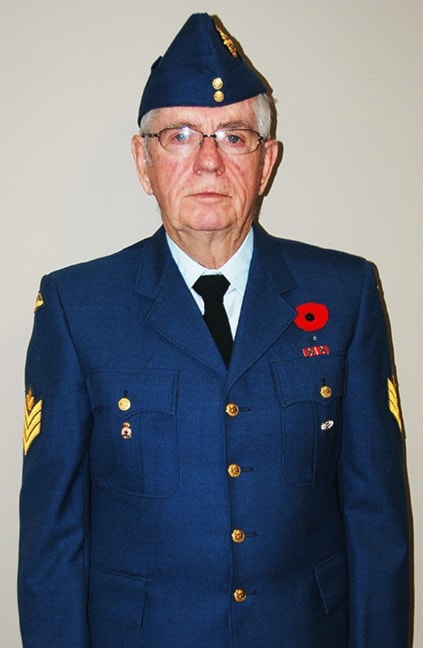With Remembrance Day approaching, it's important to acknowledge and honour the sacrifices of our military veterans.
While the tragedies of war are well documented, regardless of the conflicts that have ravaged the world throughout the last century, it is worth telling the stories of our veterans who have served, lest we forget.
'I wanted to work on airplanes'
For 33 years, Canadian military aircraft were under the watchful eye of Merlin Henry Ford.
Ford, a member of the Royal Canadian Legion Branch No. 24, served as an aircraft mechanic from 1953-1986, and helped maintain the fleet while being stationed in military bases across the country, including a brief spell overseas in France.
Born and raised in Collingwood, Nova Scotia, Ford enlisted into the Royal Canadian Air Force in 1953 to satisfy a a desire to see the world.
"I had a couple of relatives who were in the Air Force," said Ford, "one was a veteran who flew during the [Second World] war and I talked to him quite a bit and he said, 'I think you'd enjoy the life, you get a lot of travelling and see a lot of the world.'
"It seemed to be the place to go…I liked airplanes as a kid and I wanted to work on airplanes."
From the recruiting area in Oxford, Nova Scotia, Ford was stationed at air force bases in St. Johns, Quebec, Camp Borden, Ont, Greenwood, NS, Cold Lake, AB, Chatham, NB, and even did a stint overseas in France at a RCAF base in Grostenquin.
Ford started on Lancaster bombers and moved on to P-2 Neptune, a marine patrol aircraft, before servicing the CP-107 Argus, which replaced the Neptunes. Eventually, he moved onto fighter jets, spending over two decades on the F-104 Starfighter and the F-86 Sabre.
"I liked the 104 because it was sleek and fast," Ford said. "The F-5 and the F-16 — that's a superior airplane because it took the 104 10 miles to turn around, because it had such a short wing. It went like hell, but it didn't turn on a dime."
The F-104 Starfighter was the successor to the F-86 Sabre; the Starfighter was introduced into the Canadian military in 1961, following 12 years of the F-86 Sabre serving as the mainstay of the fighter jet fleet.
"The Sabre was a wonderful airplane," Ford said. "I worked on them overseas for four years and in Chatham for six years. I had about 10 years on them and 11 years on the 104.
"The Sabre was a very good airplane. Very good serviceability and dependability and it was just a pleasure to work on. The pilots loved it. They could do anything with that airplane."
While much of his time in the military included bouncing around to bases across the country, he spent four years early in his career in France at Grostenquin, which was an RCAF base in Europe as part of Canada's NATO commitment to air defence from the Soviet Union.
"We got there on Christmas Day of all times, arriving in a foreign country, didn't have a house," Ford said. "A guy gave me his address over there, another service guy, so I could take my wife with me.
"If I hadn't have gotten an address, I would've had to go by myself."
Back then, transfers were done by boat rather than on aircraft, which can sometimes make for a hairy trip across the Atlantic Ocean, which was the case for Ford and his family.
"They were seasick, they said it was one of the roughest crossings they'd ever had," Ford said. "We had to tie up in the middle of the ocean all night long because there was a ship in distress not far from us."
Grostenquin was a regional farming area and the scars from the Second World War were still visible, with bullet holes marking the outside walls of houses and structures.
"Once we got into married quarters for Canadians, it was good, but I spent the first two years out on the local economy, local housing and it wasn't very good," Ford said. "We had a mattress on the floor and an old wood stove and it was pretty tough."
Ford returned home after four years and continued to ply his trade on aircraft at bases around Canada, before retiring at the rank of Warrant Officer right were he started at Greenwood, NS.
He was even recognized by the Governor General of Canada for inventing a part that helped the Department of National Defence save time and money to fixing cracked wheel rims on the F-104.
Remembrance Day strikes a special chord for him because it is a reminder to reflect on fellow servicemen who lost their lives during his military career.
"It means a lot to everybody," Ford said, "because we had to go on parade like everyone else on Remembrance Day and there were times when a pilot was killed in an accident or whomever died — we were a squadron. As a squadron you stuck together and if one person died, whether it was a pilot or ground crew, everybody went to their funeral."
Cranbrook will be holding a Remembrance Day ceremony at the Cenotaph in Rotary Park on Friday, starting at 10:30 a.m. with the Royal Canadian Legion Branch No. 24 veterans march.
